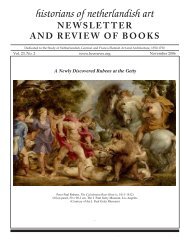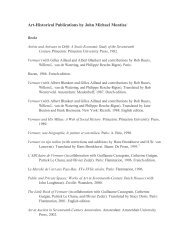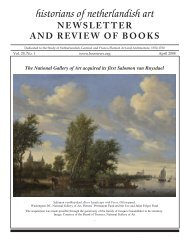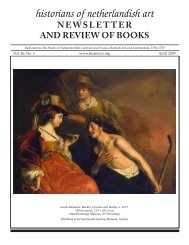newsletter - Historians of Netherlandish Art
newsletter - Historians of Netherlandish Art
newsletter - Historians of Netherlandish Art
You also want an ePaper? Increase the reach of your titles
YUMPU automatically turns print PDFs into web optimized ePapers that Google loves.
a commercial venture, widened the spectrum <strong>of</strong> those who<br />
bought images, producing new kinds <strong>of</strong> viewers and readers.<br />
This one-day conference focuses on the relations between<br />
print culture and the visual arts as a whole, looking not only<br />
at the artist’s print as produced by the peintre-graveur, but at<br />
the relations between the entire spectrum <strong>of</strong> print and what we<br />
think <strong>of</strong> now as ‘fi ne art’.<br />
Since the 1990s when the studies <strong>of</strong> Roger Chartier inspired<br />
work across many historical disciplines, much has been<br />
claimed for the impact <strong>of</strong> printed media on social, intellectual<br />
and cultural life in early modernity. The study <strong>of</strong> popular<br />
culture, the history <strong>of</strong> mentalités, book history and reception<br />
studies across a diverse range <strong>of</strong> periods and cultures have all<br />
pr<strong>of</strong>i ted from opening up the area known loosely as print culture.<br />
<strong>Art</strong> historical studies, however, have not <strong>of</strong>ten referred to<br />
this body <strong>of</strong> research. Bringing together some <strong>of</strong> the disciplines<br />
that study print culture to focus on the image and the printed<br />
text opens up new questions <strong>of</strong> concern to historians and literary<br />
historians as well as to students <strong>of</strong> the art print.<br />
We invite papers across the disciplines <strong>of</strong> print studies. Issues<br />
that we suggest are relevant include:<br />
– printed images used within legal or educational contexts,<br />
in ceremonies and festivities (‘thesis’ prints, for example)<br />
– the effect <strong>of</strong> printed images on the readership <strong>of</strong> books,<br />
political pamphlets, broadsides and ballads<br />
– the printed image incorporated within other media, such<br />
as paintings or architecture<br />
– the publication <strong>of</strong> artists’ biographies and printed portraits<br />
<strong>of</strong> artists, changing relations between artists and their<br />
publics<br />
– the publication <strong>of</strong> collections: the gathering <strong>of</strong> paintings,<br />
sculpture, and printed images accruing new signifi cance<br />
through their dissemination in print<br />
– publication and the discourse <strong>of</strong> the arts in early modernity:<br />
the effect <strong>of</strong> print on artists’ biographies, manuals on the<br />
crafts <strong>of</strong> image making, or critical refl ections about the nature<br />
<strong>of</strong> artistic beauty<br />
– printed text and printed image: the dialogue and argument<br />
between word and image within printed publications<br />
The conference grows out <strong>of</strong> a panel organized for the College<br />
<strong>Art</strong> Association annual conference, to be held in New York<br />
City in February 2011. Many more people proposed talks than<br />
could be accommodated there, and we hope that this second<br />
call for papers will allow participation by those who cannot<br />
attend the gathering in New York.<br />
Proposals may be sent by email by Jan. 10, 2011, to sheila.<br />
mctighe@courtauld.ac.uk or by mail to Dr. Sheila McTighe,<br />
Emily Gray and Anita Sganzerla, Courtauld Institute <strong>of</strong> <strong>Art</strong>,<br />
University <strong>of</strong> London, Somerset House, the Strand, London<br />
WC2R 0RN UK<br />
Call for <strong>Art</strong>icles: Journals<br />
Journal <strong>of</strong> <strong>Historians</strong> <strong>of</strong> <strong>Netherlandish</strong> <strong>Art</strong> (JHNA)<br />
The Journal <strong>of</strong> <strong>Historians</strong> <strong>of</strong> <strong>Netherlandish</strong> <strong>Art</strong> (www.<br />
jhna.org) announces the submission deadline for its sixth issue,<br />
summer 2011.<br />
Please consult the journal’s Submission Guidelines at<br />
www.jhna.org/index.php/submissions<br />
JHNA is an open-access, peer-reviewed journal published<br />
twice per year. <strong>Art</strong>icles focus on art produced in the Netherlands<br />
(north and south) during the early modern period (c.<br />
1400-c.1750), and in other countries and later periods as they<br />
relate to this earlier art. This includes studies <strong>of</strong> painting,<br />
sculpture, graphic arts, tapestry, architecture, and decoration,<br />
from the perspectives <strong>of</strong> art history, art conservation, museum<br />
studies, historiography, technical studies, and collecting history.<br />
Book and exhibition reviews, however, will continue to be<br />
published in the HNA Newsletter.<br />
The deadline for submission <strong>of</strong> articles for Issue 3: 1 is<br />
March 1 , 2011.<br />
Alison M. Kettering, Editor-in-Chief<br />
Molly Faries, Associate Editor<br />
Jeffrey Chipps Smith, Associate Editor<br />
Dutch Crossing: Journal <strong>of</strong> Low Countries Studies<br />
We invite scholars from all disciplines to submit original<br />
articles via the journal’s submissions tracking system. All submissions<br />
are blindly peer-reviewed and modifi cations may be<br />
required. Contributions should be in English, be accompanied<br />
by a 300 word abstract and provide translations <strong>of</strong> quotations<br />
in Dutch. The journal’s styleguide, full editorial policy and a<br />
cumulative index <strong>of</strong> all articles from 1977–2009 are available on<br />
the journal’s website.<br />
We are also planning to launch special theme issues <strong>of</strong><br />
Dutch Crossing from 2010 onwards, when the journal’s publication<br />
frequency will be raised to three issues per year. Apart<br />
from history, art history, literature and language we are interested<br />
in such topics as philosophy, visual arts, socio-linguistics,<br />
and popular culture. Proposals for themed issues may be sent<br />
to the editors: editors@dutchcrossing.org. Past thematic issues<br />
have been produced on such topics as Anglo-Dutch relations in<br />
the 17th Century; Williamite Scotland and the Dutch Republic;<br />
contemporary Dutch women writers; Frisian culture; Landscape<br />
Painting; and Literary Translation and Medieval Drama.<br />
Information on Subscription<br />
Since 2009, Dutch Crossing is published by Maney Publishing<br />
(London, Leeds, Cambridge, Mass.) and is available both<br />
online (via IngentaConnect) and in print (ISSN 0309-6564). It is<br />
indexed and abstracted by a growing number <strong>of</strong> international<br />
indexing and abstracting services, including the Periodicals Index<br />
Online and the British Humanities Index (ProQuest), Current<br />
Abstracts and TOC Premier (both Ebsco) and the Modern<br />
Language Association (MLA). Some free content is available on<br />
IngentaConnect.<br />
Individuals may subscribe to the journal at preferential<br />
rates by becoming a member <strong>of</strong> the Association for Low<br />
Countries Studies (ALCS) whose journal Dutch Crossing has<br />
become in 1997. Current membership fees, including subscription<br />
to Dutch Crossing are £31 (UK), $55 (US) or €40 (EU).<br />
Membership requests can be sent to A.C.Evans@sheffi eld.ac.uk.<br />
HNA Newsletter, Vol. 27, No. 2, November 2010<br />
17







